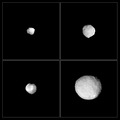Файл:Potw1749a.tif

Исходный файл (1075 × 1075 пкс, размер файла: 107 КБ, MIME-тип: image/tiff)
Описание
| Описание | VLT's SPHERE spies rocky worlds
These images were taken by ESO's SPHERE (Spectro-Polarimetric High-Contrast Exoplanet Research) instrument, installed on the Very Large Telescope at the Paranal Observatory, Chile. These strikingly-detailed views reveal four of the millions of rocky bodies in the main asteroid belt, a ring of asteroids between Mars and Jupiter that separates the rocky inner planets of the Solar System from the gaseous and icy outer planets. Clockwise from top left, the asteroids shown here are 29 Amphitrite, 324 Bamberga, 2 Pallas, and 89 Julia. Named after the Greek goddess Pallas Athena, 2 Pallas is about 510 kilometres wide. This makes it the third largest asteroid in the main belt and one of the biggest asteroids in the entire Solar System. It contains about 7% of the mass of the entire asteroid belt — so hefty that it was once classified as a planet. A third of the size of 2 Pallas, 89 Julia is thought to be named after St Julia of Corsica. Its stony composition led to its classification as an S-type asteroid. Another S-type asteroid is 29 Amphitrite, which was only discovered in 1854. 324 Bamberga, one of the largest C-type asteroid in the asteroid belt, was discovered even later: Johann Palisa found it in 1892. Today, it is understood that C-type asteroids may actually be bodies from the outer Solar System following the migration of the giant planets. As such, they may contain ice in their interior. Although the asteroid belt is often portrayed in science fiction as a place of violent collisions, packed full of large rocks too dangerous for even the most skilled of space pilots to navigate, it is actually very sparse. In total, the asteroid belt contains just 4% of the mass of the Moon, with about half of this mass contained in the four largest residents: Ceres, 4 Vesta, 2 Pallas, and 10 Hygiea. Credit: ESO/Vernazza et al. |
|---|---|
| Источник | http://www.eso.org/public/images/potw1749a/ |
| Время создания | 4 December 2017, 06:00 (release) |
| Автор или правообладатель | Credit: ESO/Vernazza et al. — Лицензия: CC BY 4.0 (Creative Commons Attribution 4.0) https://creativecommons.org/licenses/by/4.0 |
| Другие версии файла | — |
Источник файла — сайт Wikimedia Commons, куда он был загружен под одной из свободных лицензий ( https://commons.wikimedia.org/wiki/File:Potw1749a.tif ). Авторов, работавших над этим файлом см. в истории файла: https://commons.wikimedia.org/w/index.php?title=File:Potw1749a.tif&action=history
В общем случае в статьях энциклопедии Руниверсалис файлы используются в соответствии со статьёй 1274 Гражданского кодекса Российской Федерации.
История файла
Нажмите на дату/время, чтобы увидеть версию файла от того времени.
| Дата/время | Миниатюра | Размеры | Участник | Примечание | |
|---|---|---|---|---|---|
| текущий | 17:37, 13 августа 2023 |  | 1075 × 1075 (107 КБ) | I, Robot (обсуждение | вклад) | == Описание == {{Изображение | описание = <b>VLT's SPHERE spies rocky worlds</b> <p>These images were taken by ESO's SPHERE ([https://en.wikipedia.org/wiki/Spectro-Polarimetric_High-Contrast_Exoplanet_Research Spectro-Polarimetric High-Contrast Exoplanet Research]) instrument, installed on the [https://en.wikipedia.org/wiki/Very_Large_Telescope Very Large Telescope] at the [https://en.wikipedia.org/wiki/Paranal_Observatory Paranal Observatory], Chile. These strikingly-detailed views reveal f... |
Вы не можете перезаписать этот файл.
Использование файла
Следующий файл является дубликатом этого файла (подробности):
- Файл:Potw1749a.tif из на Викискладе
Следующие 3 страницы используют этот файл: